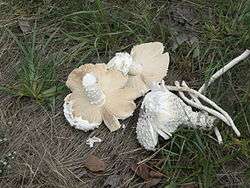Termitomyces schimperi
| Termitomyces schimperi | |
|---|---|
 | |
| Scientific classification | |
| Kingdom: | Fungi |
| Division: | Basidiomycota |
| Class: | Agaricomycetes |
| Order: | Agaricales |
| Family: | Lyophyllaceae |
| Genus: | Termitomyces |
| Species: | T. schimperi |
| Binomial name | |
| Termitomyces schimperi (Pat.) R.Heim (1942) | |
| Synonyms[1] | |
| |
Termitomyces schimperi is a mushroom associated with the termite species Macrotermes michaelseni. It grows in the northern part of Southern Africa, from northern Namibia up to the DRC and eastwards to Malawi and Mozambique.[2]
In Namibia it is commonly referred to by its Herero name Ejova (singular)/ Omajowa (plural). German Namibians refer to the mushroom as "Termitenpilz."[3]
Characteristics
The sporocarps (the fruitbody of the fungus) are the "size of a man’s fist" on emergence. They rapidly expand to 15–28 cm and may reach 40 cm in diameter. The caps are white and the thick, soft scales may be stained yellowish to reddish-brown by the soil of the mound. The scales are white underneath their uppermost layer. The pseudorhiza (a cord-like structure resembling a plant root) tapers downwards towards its origin in the termite nest, and may reach a length of about 90 cm. The lower, narrower part of the pseudorhiza has a denser consistency than the above ground-part. The sporocarps appear in groups of 5–10 around the lower parts of termite mound, and grow to roughly 50 cm above soil level. Up to 50 sporocarps have been observed around a single mound. Omajowa usually appear after soaking rains of 12 mm or more during spring, but the main crop develops during January to March which is the main rainy season. The mushroom may form on the same termite mound for many years provided that part of the hyphae is left in the mound when the cap is harvested for eating. On maturation of the fungus, the partial veil is consumed by termites.[3]
Termite association
Omajowa do not appear on all termite mounds. The mushroom occurs only on the tall termite mounds of central and northern parts of Namibia where the average rainfall is 350 mm or more. These mounds frequently reach 4 to 5 m in height and their apex is always inclined towards north. The associated termite is the Termes bellicosus also known as Macrotermes michaelseni. In Zambia the Termitomyces schimperi is found at the termite mounds of Odontotermes patruus.[3]

Distribution
Cultural association
The mushroom is seen as a symbol of growth, and prosperity by Namibians and is highly valued in Namibian culture.[4]
References
- ↑ "GSD Species Synonymy: Termitomyces schimperi (Pat.) R. Heim". Species Fungorum. CAB International. Retrieved 2015-08-20.
- ↑ Wild edible fungi a global overview of their use and importance to people, ANNEX 2: COUNTRY RECORDS OF WILD USEFUL FUNGI (EDIBLE, MEDICINAL AND OTHER USES), United Nations: Agriculture and Consumer Protection, Food and Agriculture Organization of the United Nations, retrieved 18 February 2016
- 1 2 3 Van Der Westhuizen, G.C.A; Eicker (1991). "The 'omajowa' or 'termitenpilz' Termitomyces sp. (Agaricales) of Namibia". South African Journal of Botany. 57 (1): 67–70.
- ↑ Ozondjahe Hunting Safaris. "Omajowa, Termite Hill Mushrooms in Namibia". Ozondjahe Hunting Safaris. Retrieved 7 August 2013.